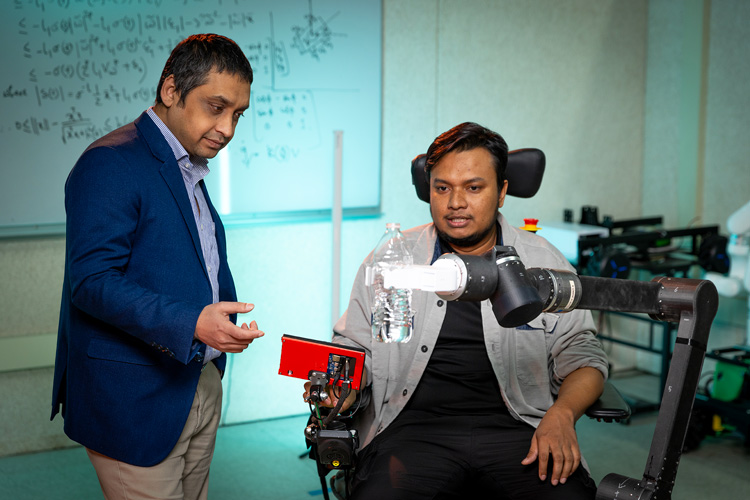
Habib Rahman (left), director of UWM’s Biorobotics Lab, and PhD student Md Mahafuzur Rahaman Khan demonstrate their lab’s assistive robotic arm that could be mounted to wheelchairs to help stroke and spinal cord injury patients perform everyday tasks. (UWM Photo/Troye Fox)
For someone who’s had a stroke or a spinal cord injury, even simple tasks like drinking a glass of water or picking up the remote can be difficult. These individuals might struggle with limited functionality in their arms and hands, often a result of nerve damage that prevents their muscles from properly receiving electrical signals from their brain.
Habib Rahman has seen these struggles firsthand.
“I’ve had family members suffer from a stroke,” said Rahman, the Richard and Joanne Grigg Professor and mechanical engineering chair at the University of Wisconsin-Milwaukee. “Even in my lab, I have a PhD student who suffered a catastrophic stroke. It can come at different ages.”
As the director of UWM’s Biorobotics Lab, Rahman is working to empower those patients. His research focuses on building advanced robots — from a wearable exoskeleton to a wheelchair-mounted assistive arm — to help people with disabilities enhance their quality of life and maintain their independence.
Journey into robotics
Rahman has loved robots since childhood. He nurtured that fascination while earning his bachelor’s degree in mechanical engineering in Bangladesh. After graduating in 2001, he pursued his master’s degree at Saga University in Japan, energized by the pioneering advancements in exoskeleton robotics being made there.
While studying in Japan, Rahman was impressed by the work being done to help the country’s large elderly population remain in their homes.
“In Japan, they’re working on exoskeleton robots to help people be more independent,” he said. “I thought that we can take this same concept and apply it to rehabilitation” for those who have had a stroke.
After earning his mechanical engineering PhD at Université du Québec in Montreal, Rahman joined UWM as a faculty member in 2015. He’s since leveraged his expertise in assistive and rehabilitation robotics to develop an array of new robotic systems for people with mobility challenges.
One such solution is a customizable exoskeleton that covers a user’s entire arm, from shoulder to wrist, to be used in physical therapy. Whirring to life with sensors and motors — and informed by artificial intelligence — the exoskeleton can tell how much motion an individual is capable of, allowing it to provide just the right amount of assistance in stimulating muscles to perform an exercise.
The future of assistive tech and rehabilitation
Rahman is working on other devices that could help make physical therapy more accessible. His lab has been developing the iTbot, a portable, assistive robotic arm that provides physical therapy to stroke patients in the comfort and convenience of their homes.
Other robot systems are meant to make daily life more manageable for people with disabilities. In 2021, Rahman and his lab members created a robotic arm that could be mounted to power wheelchairs to assist stroke and spinal cord injury patients. The device allows users to perform tasks like feeding themselves and picking up objects — even delicate items like credit cards and coffee mugs.
In 2023, the team received a $1 million grant from the National Institute on Disability, Independent Living and Rehabilitation Research to adapt the arm for additional types of users, including people with cerebral palsy, multiple sclerosis and the elderly. During the five-year grant window, Rahman and his team are partnering with the ALS Association and the Medical College of Wisconsin to find users to test the arm.
In all these efforts, Rahman and his colleagues are working to ensure that the robots are portable, affordable and covered by insurance — helping people with disabilities achieve greater success in physical therapy and accomplishing everyday tasks.
“Everybody has a right to get the highest standard of living,” Rahman said. “If I work hard, I want to (be able to) go and get a glass of water. Everybody deserves that right to be independent.”
“Even if they are satisfied for a few minutes,” he added, “even for a single task, I’ll be happy.”
Written by Alex Orlando
Link to original story: https://uwm.edu/news/uwm-professor-builds-robots-to-help-people-stay-independent/
